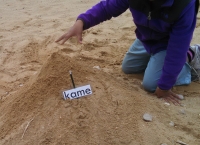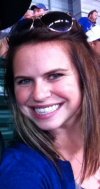Before we went to the lake, we froze large blocks of ice in cake pans. At the beach, we could push these “glaciers” around in the sand to demonstrate how the glaciers move as well as the landforms they can leave behind after they melt. We talked about moraines, kettles, kames, eskers, erratics and drumlins. After the initial discussion came the fun part. We turned 22 4th graders loose on the beach to recreate the landforms in the sand.
One group was even determined to make a kettle so deep they would hit Australia. Another group made great progress; by the time we left they had a hole that was so deep they had to lie on their stomachs and reach their arms as far as they could go to remove any more sand. I loved being able to walk around on the beach listening to students working together to build these structures, using the vocabulary they had learned to describe them. After about 30 minutes of making landforms we had to drag them away from their creations to do one final thing before heading back to the buses.
The very last activity before going back to school was to throw rocks into the lake. The most memorable moment was when a boy who had been running around all day slowed down for just a minute to learn how to skip a rock. We watched as he tried a couple times, then we started walking down the beach to check on other students. We knew he was successful when we heard him scream, “I DID IT! I SKIPPED THAT ROCK!”
Later, I noticed he put a rock in his pocket and asked what he was going to do with it. He told me he was going to go home and show his dad how to skip a rock. It is moments like this I will remember forever. Not only did we learn about glaciers, but the students made a connection to the lake that they wanted to take back home and share with their families.





